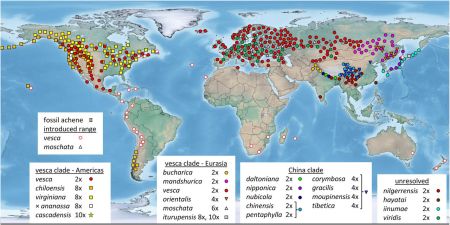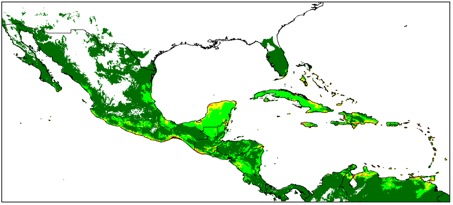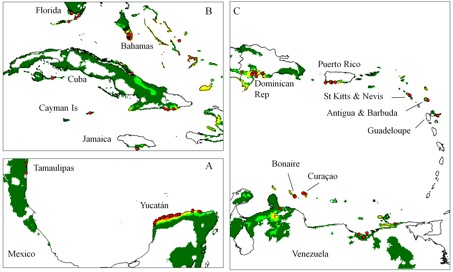- Multiplex SSR-PCR analysis of genetic diversity and redundancy in the Philippine rice (Oryza sativa L.) germplasm collection. 427 rice accessions in the national collection with similar names resolve to about 30 unique profiles. I think. The abstract is a little hard to follow, and that’s all I have access to.
- Quantitative genetic parameters of agronomic and quality traits in a global germplasm collection reveal excellent breeding perspectives for Jatropha curcas L. 375 genotypes, 7 locations and 3 years get you quite enough data to plan a decent breeding programme.
- Studies on genetic variation within old Polish cultivars of common oat. Forward into the past.
- Morphoagronomic peppers no gender pungent Capsicum spp. Amazonia. Actually nothing to do with gender. That’s a mis-translation of “genus,” if you can believe it. Paper basically says that Amazonian peppers are really variable, which is not as interesting as it might have been.
- Global Wild Annual Lens Collection: A Potential Resource for Lentil Genetic Base Broadening and Yield Enhancement. The core collection of wild annuals (which is actually a somewhat novel concept) comes mainly from Turkey and Syria, and it’s got diversity that’s not in the cultigen.
- Pigeon pea Genetic Resources and Its Utilization in India, Current Status and Future Prospects. Indian genebank evaluates the ICRISAT core and mini-core. Then does some mutation breeding :)
- Molecular genetic diversity of the pea (Pisum sativum L.) from the Vavilov Research Institute collection detected by the AFLP analysis. Molecular data does not correspond with subspecies nor ecogeographic groupings. Back to the drawing board.
- Characterization of microsatellite markers, their transferability to orphan legumes and use in determination of genetic diversity among chickpea (Cicer arietinum L.) cultivars. Chickpea SSRs are ok for other, less studied, crops too.
- From research to action: enhancing crop yield through wild pollinators. Go wild.
- Integration of phenotyping and genetic platforms for a better understanding of wheat performance under drought. You really need managed environment facilities. Didn’t a paper in Brainfood last week say what you needed was a network of field sites? I guess you need both.
- Wild almonds gone wild: revisiting Darwin’s statement on the origin of peaches. He was not entirely wrong.
- The role of roadsides in conserving Cerrado plant diversity. 70% of species is not bad, I guess. No word on whether that includes wild peanuts, but I suspect yes.
- Do living ex situ collections capture the genetic variation of wild populations? A molecular analysis of two relict tree species, Zelkova abelica and Zelkova carpinifolia. Yes and no. But this is in botanic gardens and arboreta, what about seedbanks? The cerrado people want to know…
Speaking about Speaking of Food
This special issue, “Speaking of Food: Connecting basic and applied plant science,” aims to provide concrete examples of how a wide range of basic plant science, the types of scientific studies commonly published in AJB, are relevant for the future of food. This Special Issue was inspired by Elizabeth A. Kellogg’s 2012 Presidential Address to the Botanical Society of America, and resulted in part from a symposium and colloquium by the same name that took place at the 2013 Botany meetings in New Orleans, LA. The issue editors are grateful to the Botanical Society of America, the American Society of Plant Taxonomists, and the Torrey Botanical Society for support of this work.
Special issue of the American Journal of Botany, that is. Alas, only one of the papers, the one on strawberries, is open access, though.

Comparing the niches of wild, feral and cultivated tetraploid cottons, Part 2
We’re trying something new for us this week. Dr Geo Coppens co-authored an interesting paper ((Coppens d’Eeckenbrugge, G., & Lacape, J. (2014). Distribution and Differentiation of Wild, Feral, and Cultivated Populations of Perennial Upland Cotton (Gossypium hirsutum L.) in Mesoamerica and the Caribbean PLoS ONE, 9 (9) DOI: 10.1371/journal.pone.0107458)) recently which brings together a number of our concerns: domestication, diversity, crop wild relatives, spatial analysis… He’s written quite a long piece about his research, which we’ll publish here in three instalments. This is the second instalment. Here’s the first, in case you missed it.
To investigate the origin of cultivated cotton in the New World, we also had to define the distribution of the wild precursors, which meant distinguishing True Wild Cotton (TWC) populations from feral (secondarily wild) populations. We first defined five categories: (1) TWC populations, which were described as such by cotton experts with consistent ecological and/or morphological criteria; (2) wild/feral cottons, reported to grow in protected areas and/or forming relatively dense populations in secondary vegetation; (3) feral plants living in anthropogenic habitats (field and road margins); (4) cultivated perennial cottons; and (5) plants of indeterminate status. We then organized our extensive dataset of locality information from herbaria and genebanks in the same way as Russian nesting dolls.
Avoiding the problematic comparisons between consecutive categories, we first modelled G. hirsutum distribution based on the whole sample, then reducing the sample to ‘feral’+‘wild/feral’ + TWC , then to ‘wild/feral’+TWC, and finally to TWC alone. Thus, we could see that the distribution model (we used the Maxent software for niche modelling) was not significantly affected by the successive removals of specimens classified as indeterminate, cultivated, or feral. Only the model based on TWC populations diverged very clearly, their distribution being severely restricted to a few coastal habitats, in northern Yucatán and in the Caribbean, from Venezuela to Florida (Figures 1 and 2).


A principal component analysis on climatic parameters confirmed the absence of clear differences among the climatic niches of cultivated, feral, and ‘wild/feral’ populations, contrasting strikingly with that of TWC populations, restricted to the most arid coastal environments. The TWC habitat’s harsh conditions are quite certainly related to the fact that “Gossypium is xerophytic and that even its most mesophytic members are intolerant of competition, particularly in the seedling stage” (Hutchinson, 1954). The proximity to the sea plays a role itself, for these “extreme outpost plants” (Sauer, 1967). Indeed, as Fryxell (1979) puts it, wild tetraploid cottons are strand plants adapted to mobile shorelines, with impermeable seeds adapted to salt water diffusion. The instability of their habitat “is in itself highly stable” and very ancient, so “that the pioneers are simultaneously old residents”.
Extrapolating this TWC climatic model to South America and Polynesia points towards places where other wild representatives of tetraploid Gossypium species have been reported, which gives a strong example of niche conservatism. Thus, the distribution model has perfectly captured those conditions that are related to both biotic and abiotic constraints for the development of TWC populations.
To be continued…
Nibbles: Georgian kitchen garden, Italian citrus history, Domestication infographics, AVRDC, Zambian nutrition policy, Camel-keeping, ESA states its case, Making lunch
- Podcast double: Georgian kitchen gardens (with pix) and Italian citrus.
- Domestication infographics are now officially a thing.
- Feeding the world with vegetable research, courtesy of AVRDC. Need to register, alas.
- Zambia biofortifies. Maybe they didn’t register for the above.
- Camels as biocultural artifacts.
- European Seed Association breaks down the tumultuous last 18 months of the European seed sector.
- “It takes more than 40 different species to make a simple lunch…”
Domestication and distribution: comparing the niches of wild, feral and cultivated tetraploid cottons
We’re trying something new for us this week. Dr Geo Coppens co-authored an interesting paper ((Coppens d’Eeckenbrugge, G., & Lacape, J. (2014). Distribution and Differentiation of Wild, Feral, and Cultivated Populations of Perennial Upland Cotton (Gossypium hirsutum L.) in Mesoamerica and the Caribbean PLoS ONE, 9 (9) DOI: 10.1371/journal.pone.0107458)) recently which brings together a number of our concerns: domestication, diversity, crop wild relatives, spatial analysis… He’s written quite a long piece about his research, which we’ll publish here in three instalments, over the next few days days, starting today. Enjoy!
![]() Niche Modelling has been increasingly coupled with genetic studies for the study of plant domestication and/or diffusion (e.g. Thomas et al., 2012, on cacao; Russell et al., 2014, on barley). However, there has been relatively little interest in the effects of domestication and cultivation on distribution. Comparing the distributions of wild and cultivated hog plums in Meso- and Central America, Miller and Knouft (2006) found that the crop’s environmental range was significantly wider than that of its wild relatives observed in the dry forests, which was suspected to result from selection and attendant adaptation under domestication.
Niche Modelling has been increasingly coupled with genetic studies for the study of plant domestication and/or diffusion (e.g. Thomas et al., 2012, on cacao; Russell et al., 2014, on barley). However, there has been relatively little interest in the effects of domestication and cultivation on distribution. Comparing the distributions of wild and cultivated hog plums in Meso- and Central America, Miller and Knouft (2006) found that the crop’s environmental range was significantly wider than that of its wild relatives observed in the dry forests, which was suspected to result from selection and attendant adaptation under domestication.
This interpretation seems related to a combination of common ideas about species habitats, distribution modelling and the effects of human selection and diffusion on crop adaptation. Most correlative species distribution modelling has been based on the use of abiotic environmental variables, and the best documented are climatic ones. As a result, many authors think of their models in terms of climatic envelopes corresponding to the physiology and phenology of species, and remain cautious about their capacity to capture biotic effects. Therefore, it appears logical to relate the wider crop environmental range, as compared to their wild relatives, to adaptive selection under/after domestication.
Results obtained on perennial cotton from Mesoamerica and the Caribbean underline the interest of a more ecological interpretation (Coppens d’Eeckenbrugge and Lacape, 2014). Among the four independently domesticated cotton species, Gossypium hirsutum L. is by far the most widely cultivated, even in warm temperate conditions, at latitudes of up to 30°. It shares its AD allotetraploid genome with the other American domesticated cotton, G. barbadense L., native to Ecuador and Peru, and three wild species, G. darwinii Watt (Galapagos), G. mustelinum Miers ex Watt (Northeastern Brazil), and G. tomentosum Nutt. ex Seem. (Hawaii). The absence of American diploid species bearing the A genome led Hutchinson et al. (1947) to the conclusion that the A parent was an African domesticate brought by man, implying that the first allotetraploid cottons were cultivated.
On the contrary, Fryxell (1979) and Sauer (1967) recognized wild populations of G. hirsutum in Yucatán and various localities in the Caribbean. The existence of these “truly wild cottons” (TWC) was progressively substantiated by their particular seed traits (Stephens, 1965) and the isozyme study of Brubaker & Wendel (1994), indicating that the TWC populations of northern Yucatán were the likely ancestors of Mesoamerican cultivated races. More recently, molecular genetics supported Fryxell’s views, confirming that all five allotetraploid cotton species originated from a single hybridization event that took place during the Pleistocene, some 1-2 million years ago (Wendelet al. 2010). However, no systematic studies were undertaken and TWC populations were very poorly represented in subsequent studies of tetraploid cotton genetic resources. In particular, the status of TWC populations from the Caribbean was not clarified. A major practical problem was the difficulty to distinguish TWC populations from feral (secondarily wild) populations.
To be continued…